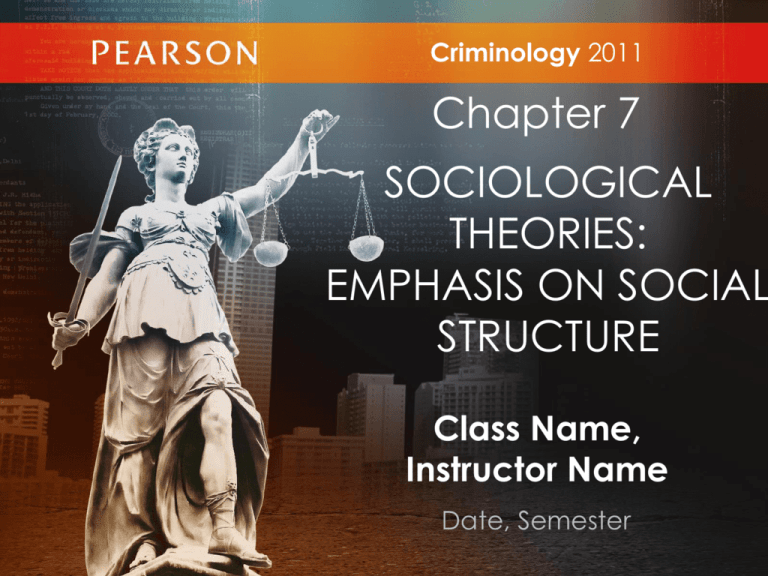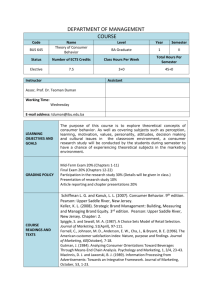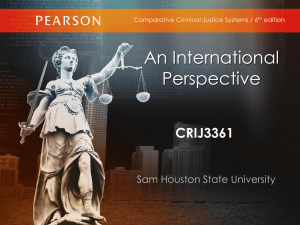
Criminology 2011
Chapter 7
SOCIOLOGICAL
THEORIES:
EMPHASIS ON SOCIAL
STRUCTURE
Class Name,
Instructor Name
Date, Semester
CHAPTER OBJECTIVES
7.1
7.2
7.3
7.4
Appreciate Emile Durkheim's contributions toward
understanding deviance as a normal phenomenon and the
influence of structural forces on individual behavior.
Be familiar with the social disorganization and social ecology
approaches, including the work of Park and Burgess, Shaw and
McKay, and more recent revivals of these approaches,
especially with regard to economic deprivation and Stark's
theory of deviant places.
Be able to critique social disorganization theory.
Be familiar with anomie theory, including Merton's typology of
logical adaptations to anomie, and the defense and extension
of this approach.
© 2012 by Pearson Higher Education, Inc
Upper Saddle River, New Jersey 07458 • All Rights Reserved
CHAPTER OBJECTIVES
7.5
7.6
7.7
Be acquainted with general strain theory.
Be familiar with subcultural theory, including Cohen's status
frustration model (and evaluation), Miller's focal concerns (and
evaluation), Cloward and Ohlin's differential opportunity theory
(and evaluation) and Wolfgang and Ferracuti's subculture of
violence perspective (and evaluation).
Appreciate how structural theories of crime fail to explain why
females in poor urban areas have lower crime and delinquency
rates than males in these same areas.
© 2012 by Pearson Higher Education, Inc
Upper Saddle River, New Jersey 07458 • All Rights Reserved
Learning Objectives
After this lecture, you should be able to complete the following Learning Outcomes
7.1
Appreciate Emile Durkheim's
contributions toward understanding
deviance as a normal phenomenon
and the influence of structural forces
on individual behavior.
© 2012 by Pearson Higher Education, Inc
Upper Saddle River, New Jersey 07458 • All Rights Reserved
7.1
5
© 2012 by Pearson Higher Education, Inc
Upper Saddle River, New Jersey 07458 • All Rights Reserved
Learning Objectives
After this lecture, you should be able to complete the following Learning Outcomes
7.2
Be familiar with the social disorganization
and social ecology approaches, including
the work of Park and Burgess, Shaw and
McKay, and more recent revivals of these
approaches, especially with regard to
economic deprivation and Stark's theory of
deviant places.
© 2012 by Pearson Higher Education, Inc
Upper Saddle River, New Jersey 07458 • All Rights Reserved
7.2
The Development of Social Disorganization Theory
W. I.
Thomas &
Florian
Znaniecki
Robert
Park &
Ernest
Burgess
Clifford
Shaw &
Henry
Mckay
Chicago
School of
Criminology
© 2012 by Pearson Higher Education, Inc
Upper Saddle River, New Jersey 07458 • All Rights Reserved
7.2
Zone V
Zone IV
Zone III
Zone II
ResidentialZone
Zonein Transition
Single-Family
Ghetto
Dwellings
Slum
Residential Hotels Little Sicily
Bright-Light Area Chinatown
Apartment Houses
VICE
Restricted
Residential District
Zone City Center Zone Of
Commuter
Working Class
Zone
I
Second
Bungalow
Immigrant
Section
Settlement
Deutschland
“Two-Flat” Area
Roomers Underworld
Concentric Zones
© 2012 by Pearson Higher Education, Inc
Upper Saddle River, New Jersey 07458 • All Rights Reserved
7.2
Low
Socio-Economic
Status
Lack of Informal
Social Control
Residential
Instability
Social
Disorganization
Delinquency
Cultural
Transmission
Ethnic
Heterogeneity
9
© 2012 by Pearson Higher Education, Inc
Upper Saddle River, New Jersey 07458 • All Rights Reserved
7.2
Social
Disorganization
Economic
Deprivation
Concentrated
Disadvantage
© 2012 by Pearson Higher Education, Inc
Upper Saddle River, New Jersey 07458 • All Rights Reserved
7.2
Kinds of
Places
vs.
Kinds of
People
© 2012 by Pearson Higher Education, Inc
Upper Saddle River, New Jersey 07458 • All Rights Reserved
Learning Objectives
After this lecture, you should be able to complete the following Learning Outcomes
7.3
Be able to critique social
disorganization theory.
© 2012 by Pearson Higher Education, Inc
Upper Saddle River, New Jersey 07458 • All Rights Reserved
7.3
Critiques of Social
Disorganization Theory
Heavy reliance on using official records for measuring crime
and delinquency
Imprecision in the concept of social disorganization
Most people living in the “crime zones” are not offenders
© 2012 by Pearson Higher Education, Inc
Upper Saddle River, New Jersey 07458 • All Rights Reserved
Learning Objectives
After this lecture, you should be able to complete the following Learning Outcomes
7.4
Be familiar with anomie theory,
including Merton's typology of logical
adaptations to anomie, and the
defense and extension of this
approach.
© 2012 by Pearson Higher Education, Inc
Upper Saddle River, New Jersey 07458 • All Rights Reserved
7.4
© 2012 by Pearson Higher Education, Inc
Upper Saddle River, New Jersey 07458 • All Rights Reserved
7.4
Merton’s Five Modes of Adaptation
Conformity
Innovation
Ritualism
Retreatism
© 2012 by Pearson Higher Education, Inc
Upper Saddle River, New Jersey 07458 • All Rights Reserved
Rebellion
7.4
Defenses and Extensions of Merton’s Approach
Social Class and Offending
Supported for Serious Offenses
Can Be Extended to Explain
White-Collar Crime
Institutional Anomie
© 2012 by Pearson Higher Education, Inc
Upper Saddle River, New Jersey 07458 • All Rights Reserved
Learning Objectives
After this lecture, you should be able to complete the following Learning Outcomes
7.5
Be acquainted with general strain
theory.
© 2012 by Pearson Higher Education, Inc
Upper Saddle River, New Jersey 07458 • All Rights Reserved
7.5
General Strain Theory
Failure to
Achieve
Positively
Valued
Goals
Removal of
Positively
Valued
Stimuli
Presentation
of Noxious
Stimuli
STRAIN
CRIME
© 2012 by Pearson Higher Education, Inc
Upper Saddle River, New Jersey 07458 • All Rights Reserved
Learning Objectives
After this lecture, you should be able to complete the following Learning Outcomes
7.6
Be familiar with subcultural theory, including
Cohen's status frustration model (and
evaluation), Miller's focal concerns (and
evaluation), Cloward and Ohlin's differential
opportunity theory (and evaluation) and
Wolfgang and Ferracuti's subculture of
violence perspective (and evaluation).
© 2012 by Pearson Higher Education, Inc
Upper Saddle River, New Jersey 07458 • All Rights Reserved
7.6
Reaction Formation
Individual
Deviance
Status
Frustration
and Reaction
Formation
Collective
Solution:
Create New
Status System
Opposite of
Middle-Class
Values
Lower/Working
Class Youth
Subcultural
Values Emerge
© 2012 by Pearson Higher Education, Inc
Upper Saddle River, New Jersey 07458 • All Rights Reserved
Gang Delinquency
Cannot
Obtain
Middle Class
Status
7.6
Walter Miller’s Focal Concerns
Trouble
Toughness
Smartness
Excitement
Fate
© 2012 by Pearson Higher Education, Inc
Upper Saddle River, New Jersey 07458 • All Rights Reserved
Autonomy
7.6
Differential Opportunity Theory
Criminal
Subculture
Goals
Alienation
Gap
Means
Externalize
Blame
Access to
Others with
Same Problem
Conflict
Subculture
Retreatist
Subculture
Lower/Working
Class Youth
© 2012 by Pearson Higher Education, Inc
Upper Saddle River, New Jersey 07458 • All Rights Reserved
7.6
© 2012 by Pearson Higher Education, Inc
Upper Saddle River, New Jersey 07458 • All Rights Reserved
Learning Objectives
After this lecture, you should be able to complete the following Learning Outcomes
7.7
Appreciate how structural theories of
crime fail to explain why females in
poor urban areas have lower crime
and delinquency rates than males in
these same areas.
© 2012 by Pearson Higher Education, Inc
Upper Saddle River, New Jersey 07458 • All Rights Reserved
7.7
Social structure
theories may
explain only male
offending
Economic
marginality
© 2012 by Pearson Higher Education, Inc
Upper Saddle River, New Jersey 07458 • All Rights Reserved
CHAPTER SUMMARY
7.1
7.2
7.3
7.4
Appreciate Emile Durkheim's contributions toward
understanding deviance as a normal phenomenon and the
influence of structural forces on individual behavior.
Be familiar with the social disorganization and social ecology
approaches, including the work of Park and Burgess, Shaw and
McKay, and more recent revivals of these approaches,
especially with regard to economic deprivation and Stark's
theory of deviant places.
Be able to critique social disorganization theory.
Be familiar with anomie theory, including Merton's typology of
logical adaptations to anomie, and the defense and extension
of this approach.
© 2012 by Pearson Higher Education, Inc
Upper Saddle River, New Jersey 07458 • All Rights Reserved
CHAPTER SUMMARY
7.5
7.6
7.7
Be acquainted with general strain theory.
Be familiar with subcultural theory, including Cohen's status
frustration model (and evaluation), Miller's focal concerns (and
evaluation), Cloward and Ohlin's differential opportunity theory
(and evaluation) and Wolfgang and Ferracuti's subculture of
violence perspective (and evaluation).
Appreciate how structural theories of crime fail to explain why
females in poor urban areas have lower crime and delinquency
rates than males in these same areas.
© 2012 by Pearson Higher Education, Inc
Upper Saddle River, New Jersey 07458 • All Rights Reserved





